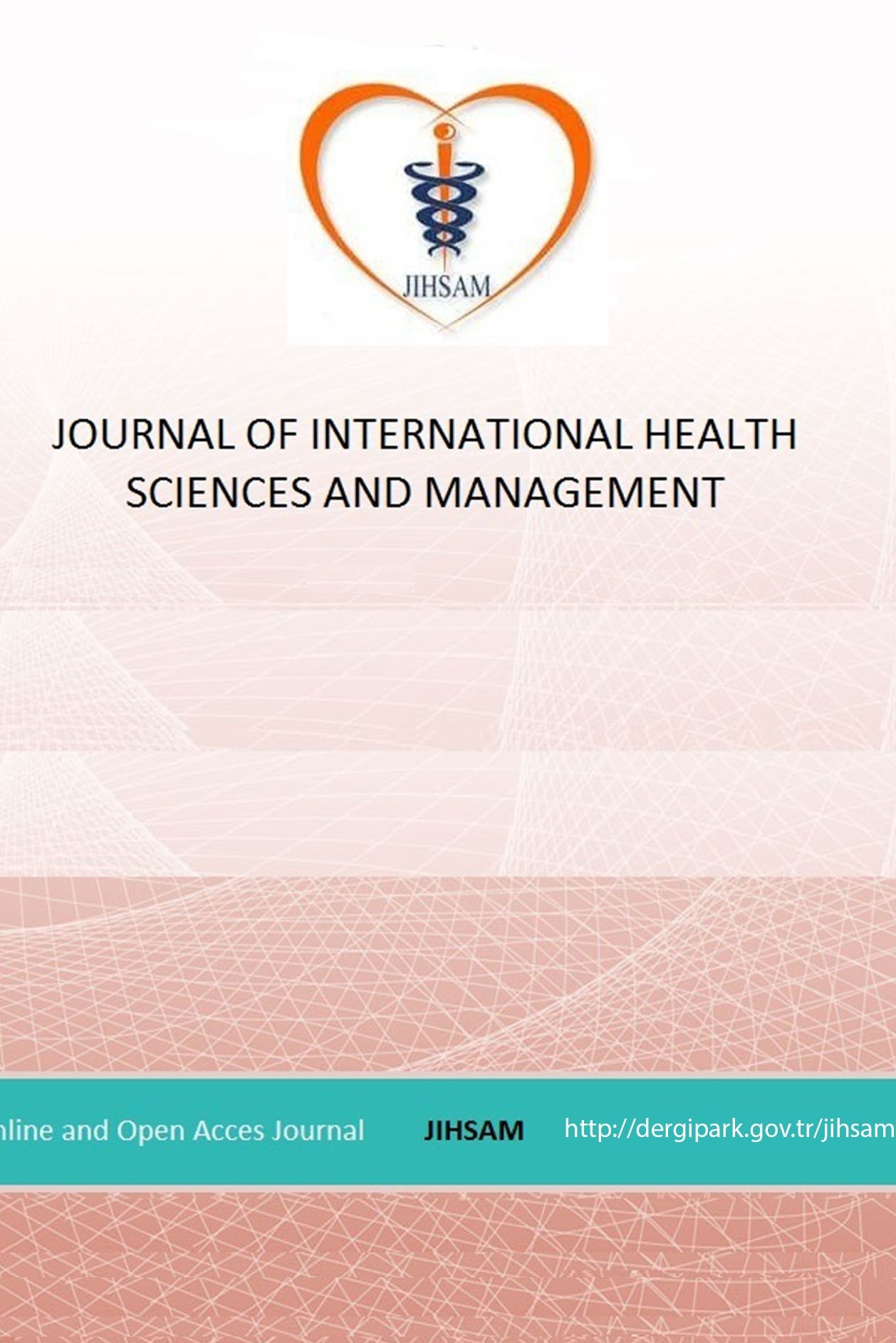THE PERCEPTIONS OF NURSES ABOUT PATIENT SAFETY CULTURE: AN EXAMPLE PROVINCE IN NORTH EAST OF TURKEY
THE PERCEPTIONS OF NURSES ABOUT PATIENT SAFETY CULTURE: AN EXAMPLE PROVINCE IN NORTH EAST OF TURKEY
patient safety patient safety culture, nurse, nursing,
___
- Iha A. ed. Summary of the evidence on patient safety: implications for research. Geneva. World Health Organization, The Research Priority Setting Working Group of the Alliance for Patient Safety. 2008.
- International Council of Nurses (ICN). Nurses: A Force for Change, Care Effective, Cost Effective (İnternet). 2015. (cited 2020 March 10). Avaliable from: https://www.ghdonline.org/uploads/IND_2015_Eng.pdf
- Chassin MR, Loeb JM. High‐reliability health care: Getting there from here. The Milbank Quarterly. 2013;91(3):459-90. National Patient Safety Foundation (NPSF) (İnternet). 2019. [Available from: http://www.ihi.org/Topics/PatientSafety/Pages/Overview.aspx
- World Health Organization (WHO). 2020. [Available from: https://www.who.int/patientsafety/en/
- James JT. A new, evidence-based estimate of patient harms associated with hospital care. Journal of patient safety. 2013;9(3):122-8.
- Pazarcıkcı F, Efe E. Patient safety in pediatric nursing. SDU Journal of Health Science Institute. 2018;9(2):169-74.
- Rashvand F. Designing and validation of safe nursing care assessment tool: A sequential exploratory mixed-methods design. Tehran Medical University School of Nursing and Midwifery; 2014.
- Vaismoradi M, Salsali M, Turunen H, Bondas T. Patients' understandings and feelings of safety during hospitalization in Iran: A qualitative study. Nursing & Health sciences. 2011;13(4):404-
- Türk G, Eşer İ. Patient safety in a hospital setting and nursing approach. J of Hospital Management. 2007;11(1-2):16-20.
- Türkmen E, Altuntas S, Baykal Ü, Seren Ş. Development of patient safety culture scale. J of Anatolian Nursing and Health Sciences. 2011;14(4):38-46.
- Mitchell PH. Defining patient safety and quality care. Patient safety and quality: An evidence-based handbook for nurses: Agency for Healthcare Research and Quality (US); 2008.
- Rızalar S, Büyük ET, Şahin R, As T, Uzunkaya G. Patient safety culture and influencing factors of nurses. Electronic J of September 9th University Nursing Faculty. 2016;9(1):9-15.
- Korkmaz O. Nurses’ perception of managers’ attitude to patient safety. J of Social Sci Inst of DEU. 2012;14(4):91-112.
- Karaca A, Arslan H. A study for evaluation of patient safety culture in nursing services. J of Helath and Nursing Management. 2014;1(1):9-18.
- Li AT. Teamwork climate and patient safety attitudes: associations among nurses and comparison with physicians in Taiwan. Journal of nursing care quality. 2013;28(1):60-7.
- Nazik E, Var E, Yıkar SK, Nazik S, Karadağ AG, Gökçe R, et al. Determination of patient safety culture perceptions of health professionals: The example of the maternity and children’s hospital. J Contemp Med. 2018;8(3):251-8.
- Özdemir FK, Şahin ZA. Perceptions of Nurses Regarding The Patient Safety Culture: The Kars Case. ODU Journal of Medicine. 2015;2(3):139-44.
- Bahrami M, Aliakbari F, Aein F. Iranian nurses’ perception of essential competences in disaster response: A qualitative study. Journal of education and health promotion. 2014;3.
- Acency for Healthcare Research and Quality (AHRQ) (İnternet). 2014. [Available from: https://psnet.ahrq.gov/primer/culture-safety
- Gündoğdu SK, Bahçecik N. Determining Nurses’ Perception of Patient Safety Culture. J of Anatolian Nursing and Health Sciences. 2012;15(2):119-28.
- Göz F, Kayahan M. Evaluation of the Patient Safety Culture: Survey of Nurses. J of Education and Reseach in Nursing. 2011;8(2):44-50.
- Adigüzel O. Hasta güvenliği kültürünün sağlık çalışanları tarafından algılanmasına yönelik bir araştırma. Dumlupınar Üniversitesi Sosyal Bilimler Dergisi. 2010: (28).
- Bıçakçı H, Ağırbaş İ, Bülüç F, Turgut M. Financial analysis in private hospitals. 3th International Conference on Social Sciences; 9th- 11th November; Ankara, Turkey, 2018. p. 782-7.
- Erdagı S, Özer N. Examining practice environments, patient safety culture perceptions and burnout status of nurses working in surgical clinics. J of Anatolian Nursing and Health Sciences. 2015;18(2):94-106.
- Saraç A. Knowledge and attidudes of healt care personel working at healt centers in center Trabzon on patient rights, patient safety and their rights. Trabzon: Karadeniz Techincal University; 2009.
- Yayın Aralığı: Yılda 2 Sayı
- Başlangıç: 2015
- Yayıncı: Sedat BOSTAN
Mustafa IŞIK, Onur YARAR, Didem SÖYLEMEZ SUR
DOES BUSİNESS SATİSFACTİON AFFECT THE LİFE SATİSFACTİON? EXAMPLE OF HEALTH SCİENCES ACADEMİCS
Yasemin URGANCI, Cansu YILMAZ, Sultan ÇEÇEN, Hanife ÖZÇELİK
The Assessment of Turkey’s Lack of Resilience to Disasters and Hazards with IDB Indicator System
Ünal YAPRAK, Turgut ŞAHİNÖZ, Saime ŞAHİNÖZ
Effect of health education about personal hygiene on student’s health in primary school
Amira BOSHRA, Abdalbasit MARIOD
THE PERCEPTIONS OF NURSES ABOUT PATIENT SAFETY CULTURE: AN EXAMPLE PROVINCE IN NORTH EAST OF TURKEY
Aysun BAYRAM, Afife YURTTAŞ, Mağfiret KARA KAŞIKÇI
THE IMPACT OF PERCEIVED SOCIAL SUPPORT ON PERCEPTION OF HEALTH STATUS IN ISPARTA
ANALYSIS OF SOME CONCEPTS RELATED TO THE ENVIRONMENT AND HEALTH WITH THE N-GRAM METHOD
Ali ÇİFTÇİ, Alaaddin VURAL, Mustafa Nuri URAL
Esendal GÜLEÇ, Kadriye SÖNMEZ, Suat PEKER, İbrahim Halil CANKUL
